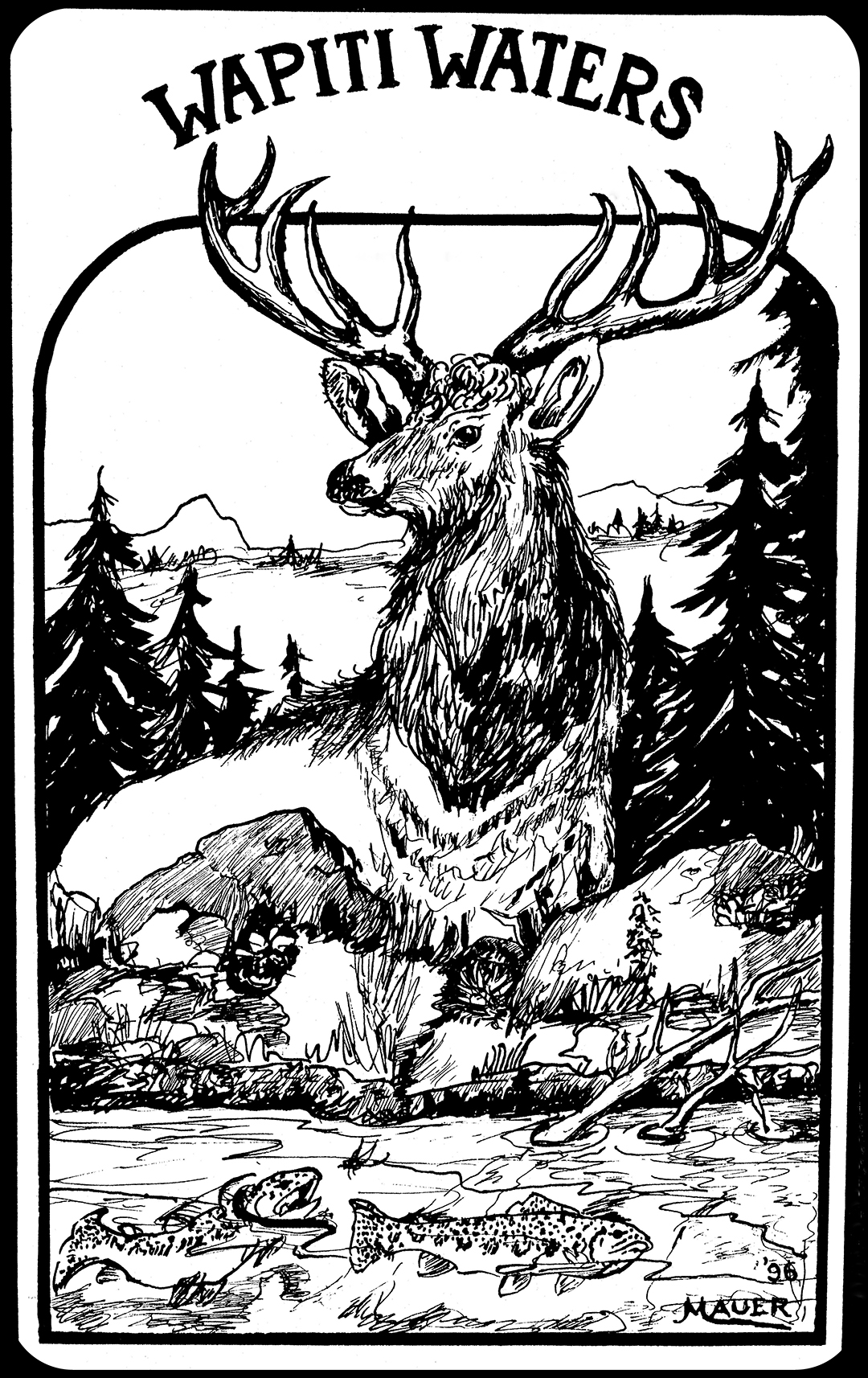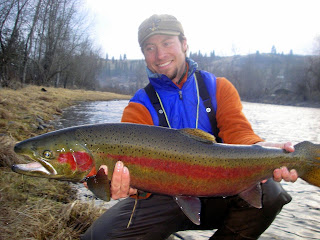
by Merle Ann Loman | Jan 25, 2009 | iiii Winter/Snow, Other
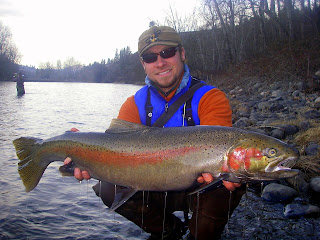 Our friend and fellow outfitter, Josh Lauer, just sent these photos in. He was near a town called Kooskia (no McDonald’s restaurant there) located at the confluence of the Middlefork and Southfork of the Clearwater River, along Lewis Clark US Highway 12 in North Central Idaho.
Our friend and fellow outfitter, Josh Lauer, just sent these photos in. He was near a town called Kooskia (no McDonald’s restaurant there) located at the confluence of the Middlefork and Southfork of the Clearwater River, along Lewis Clark US Highway 12 in North Central Idaho.
Fly Fishing for steelhead is exciting! He said these two fish are in the smoker right now. What a pair of bookends they would make.
by Merle Ann Loman | Jan 25, 2009 | iiii Winter/Snow
There is not much snow in the Bitterroots right now, at least not enough to find a close place to cross country ski. These photos show a desperate attempt to exercise near home and find a place to ski!
Jack and I are spending about 8 hours a day working on the business, then attend meetings, Lady Griz Basketball (my daughter plays), play music with the band, and more. Winter is busier than you might think. He ties flies, writes material, works on gear and vehicles. I do admin and web stuff. The work is necessary, but so is a mind and fitness break. For Jack’s work and for health, it is important to stay fit. We work in couple of hours of outdoor activity each day. The photos show one of our outdoor excursions with our dog, Bela.

by Merle Ann Loman | Jan 24, 2009 | Conservation/benefits/organizations, ii Summer
 Trout Unlimited On the Rise
Trout Unlimited On the Rise
Clark Fork River: Missoula, MT
Sat, Jan 24, 2:00 PM Run Time: 30 min.
OUTDR 153 on Dish Network
Genre: Sports, Sports non-event
First Aired: Jan 23, 2009
Topic: Fishing the Clark Fork RiverFor me, the jury is out on this new TU TV show, but in this episode, my favorite outfitter is fishing with Host Frank Smethurst. Check it out.
One of our clients saw it and emailed, “Hey Jack, I saw you this morning on Trout Unlimited TV fishing the Clark Fork. In early July and I will try to fish a day or two with you. The Clark Fork looked like a lot of fun. Hope all is well.”


by Merle Ann Loman | Jan 21, 2009 | Clark Fork
Join us to hear updates on the Milltown Dam Removal and River Restoration project. Speakers include David Schmetterling, FWP; Russ Forba, EPA; and Doug Martin, NRDP.
UPDATE ON:
Timeline for remaining cleanup
Upcoming river restoration
Fisheries health
After plugging the Clark Fork-Blackfoor confluence for 100 years, the dam is a part of history.

Milltown Cleanup Update for Guides
On Wednesday, Feb. 4, from 5:30-7:30PM, the Clark Fork Coalition and Montana Trout Unlimited will co-host Guiding Without the Dam, an update for guides on the Milltown cleanup project, at the Coalition offices at 140 S. 4th St. W. Free pizza and beer will be served.
Please RSVP to info@clarkfork.org or 406-542-0539.
Clark Fork Coalition
Montana Trout Unlimited

by Merle Ann Loman | Jan 20, 2009 | Friends
Introducing Alan Pilkington’s newest book!
In this compilation of short stories and poetry centered on rivers, mountains, and wild locations of great natural beauty, novelist and avid outdoors man Alan Pilkington shares the memories of the unforgettable times he spent as a young man on the banks of a mountain river outside of Melbourne, Australia.
Pilkington was born into a family where the men went to the mountains and fished for trout in the tumbling streams of the southern parts of Australia’s Great Dividing Range. Cultivating a lifelong love affair with the outdoors through his many stays in cabins built by successive family generations, he learned about the bush and its creatures while gaining a deep appreciation for the value of wilderness. Pilkington shares the journal entries, stories, and poems he composed while on fly-fishing and hunting adventures in Australia, New Zealand, England, the United States, Zimbabwe, and Tanzania–some serious, some lighthearted–all with a focus on rivers and how they provide inner-peace to all who seek it through them. Rivers of My Memory will touch anyone with a passion for the wilderness and who have rivers happily entwined in their memories.
Note from Alan:
Dear Friends,
Thank you for supporting my writing in the past. Rivers of My Memory is my first published work of short stories and poems. It is now available.
If you’d like to learn more about it, go to my web site http://www.alanpilkington.com/; you’ll find links there to the publisher and to online
book sellers.
Or, simply go to iUniverse, Amazon, or Barnes and Nobles.
Thank you,
Alan Pilkington
Blog note: Alan is a friend of ours. With that being said, I love his novels. I haven’t read this yet…it is just out. I am anxious to open the cover and get started. With his other books, I became immersed and didn’t want them to end. You will want to check them out.
Click this link see another post about Alan’s outdoor adventures.

by Merle Ann Loman | Jan 16, 2009 | hunting/fauna/flora, iiii Winter/Snow, Other
UPDATE January 26: I found that the Billings Gazette published this story January 8. It is much more complete. See it here: Buck floatsdown Yellowstone River on ice chunks By BRETT FRENCH of The Gazette Staff.
Original Wapiti Post text:

A friend sent us these photos today. Brrrr….
An unidentified photographer took these pictures in Miles City Montana where the Tongue River flows into the Yellowstone River. The buck made it to shore. The photographer saw him jump to safety when the ice jammed close to shore.
http://www.outdoordir.com/
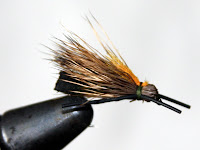
by Merle Ann Loman | Jan 12, 2009 | Bitterroot, Flies, i Spring

In the “Banana Belt” of western Montana, anglers not only have one of the longest fishing seasons in the state but also some of the finest dry-fly fishing at a time the fly fisherman needs it the most – in early spring. Flowing through the heart of the Bitterroot valley, the Bitterroot River has a hatch that has excited anglers for a couple of decades particularly after many articles have been published. Obviously, it is no longer a secret. I am talking about the
skwalla stonefly hatch. The hatch is actually one of the several important insects to emerge in a typical western Montana spring.
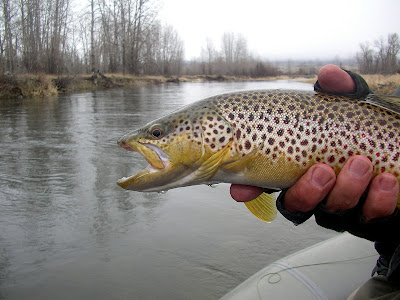
by Merle Ann Loman | Jan 11, 2009 | Bitterroot, i Spring
 For those who are interested in spring fly fishing on the Bitterroot River in Montana, I am posting a series of slideshows for March, April and May.
For those who are interested in spring fly fishing on the Bitterroot River in Montana, I am posting a series of slideshows for March, April and May.
This blog entry is for March since we begin our new year of boat fly fishing in this month. The earliest photo I have is on March 13. On any given day, you can have sun, snow, sleet, rain or a mixture of all of it. When you are floating, it is important to know the river and your boat – understanding the type of water and the distance between put-ins and take-outs. We always take a thermos of hot coffee (or cocoa) and/or soup along, and we dress in layers. It can be exhilarating to experience weather changes, the related hatches and trout feeding responses, so hold on to your hat! Remember in this season, if today is not great fishing, tomorrow probably will be. The message here is be patient and plan for at least a few days. It will be worth it.
Note: one of the photos of Jack is from the Clark Fork. We also fish the Blackfoot, Big Hole and Missouri, depending on the weather.
These photos are varied in quality. To view the slideshow in full screen mode, click View Album and choose “Slide Show.”
A future entry will show the river in April. Besides featuring fish, it will have more photos of scenes including wildlife and birds. The river bottom is a “happening place” in the spring.

by Merle Ann Loman | Jan 7, 2009 | Flies
 In guiding fly fishers over the years, I’ve noticed that clearly the single most important criterion for clients fishing out of a boat is fly visibility. Many great all-purpose and attractor dry flies work extremely well. Various colored Wulffs, humpies, parachutes, and the elk hair caddis come to mind — all proven patterns that catch lots of trout, but are not always easy to see.
In guiding fly fishers over the years, I’ve noticed that clearly the single most important criterion for clients fishing out of a boat is fly visibility. Many great all-purpose and attractor dry flies work extremely well. Various colored Wulffs, humpies, parachutes, and the elk hair caddis come to mind — all proven patterns that catch lots of trout, but are not always easy to see.
Another great all-purpose pattern is the Down-Wing Drake, developed by Phil Wright — nothing more than a grey thread body, a deer hair tail and down-wing, and a grey hackle wrapped forward of the down-wing. It’s a wonderful caddis and mayfly imitator. The only problem is that neither tired old eyes nor younger eyes accustomed to perusing the Wall Street Journal can see it.
Parachute dry flies are great, too. One can drag them around to the feeding lanes and they usually don’t sink or tip over. They seem to land with their wings upright most of the time and are easily seen with the naked eye, especially if tied with orange poly pro yarn or various colors of antron body wool for the upright wing. The high-visibility orange parachutes have been on the market for many years in various incarnations.
I’ve experimented with different down-winging schemes for a hi-vis orange, hot pink or white caddis parachute. Feedback from stubborn, hard-headed guide associates and friends has been extremely important in determining which combinations work best. In addition, I have had the opportunity to watch numerous clients of varying skill try them under differing water and light conditions. Thus has evolved “Banjo Jack’s Parachute Caddis.” Orange and hot pink seem easier to see under a sunny sky, while antron white seems to show up best under cloud cover.
By tying in a small clump of dark to medium-dark deer hair down-wing style behind the parachute wing, I’ve found an excellent caddis and /or mayfly emerger that is easy to see. Early to mid-summer fishing on many western waters can find both caddis and mayfly species throughout the day and Banjo Jack’s Parachute Caddis fits the bill in a variety of sizes and body colors.
I’ve varied body materials using both synthetic and natural materials, but peacock herl and hare’s ear dubbing ride low on the surface film and have proven very effective. A wire rib greatly increases the durability of the herl. You can vary the materials and even try a short tail of marabou or sparkle yarn. Give this pattern a chance and I’ll bet you will enjoy the results. It is particularly good in smaller sizes, like 16’s.
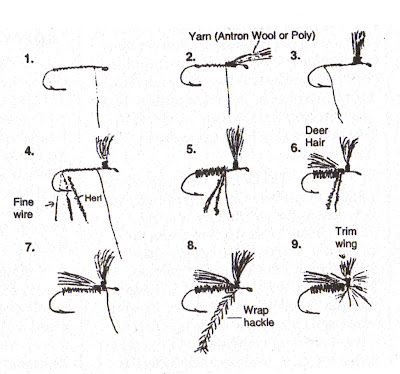
The directions for tying are as follows:
- Start at the eye. Give head a good bed of thread and bring thread toward the eye of the hook.
- One-quarter shank length behind the eye, tie in a couple of strands of orange poly yarn with 6 good wraps and trim off as closely as possible. (The amount of poly yarn varies with hook size)
- Pull up the yarn into a post-wing and use 10 clockwise wraps around the base of the post; then reverse the thread and put on ten counter-clockwise wraps; don’t trim the wing top. This forms a sturdy base for wrapping the hackle.
- Move the thread to the back of the hook and tie in the body materials, e.g. three strands of peacock herl and some fine copper wire. Wrap the thread back up to behind the wing.
- Wrap the herl to behind the wing, but don’t crowd the wing and don’t cut the herl strands. Then wrap the wire to rib the body and trim the wire.
- Next take a sparse clump of deer body hair (flank or shoulder area) and trim the butts evenly. Trim so that the ends won’t extend too far beyond the end of the hook.
- Tie in the down wing firmly. Wrap the herl over the butts and under the orange wing, then tie off.
- Tie in a grey dun or grizzly hackle sword and wrap parachute-style around the base of the orange poly wing. Five or six turns will float the fly just fine.
- Whip-finish the head, cut the thread and trim the orange wing fairly short.

by Merle Ann Loman | Jan 6, 2009 | Bitterroot, i Spring
 Dusty Bernard has been coming to the Bitterroot for years. Some of the regulars are Don Young, Jim Shultz, Jim Ogle, Peter Zouvas, Gary Spradling, Dusty and his son Tim.
Dusty Bernard has been coming to the Bitterroot for years. Some of the regulars are Don Young, Jim Shultz, Jim Ogle, Peter Zouvas, Gary Spradling, Dusty and his son Tim.
I am posting a slideshow of select photos through the years. We wish you all a Happy New Year. It would be great to see you in 2009.
To view in full screen, click on “View Album” then select “Slide Show.” You might need to slow it down a bit (+).

 Our friend and fellow outfitter, Josh Lauer, just sent these photos in. He was near a town called Kooskia (no McDonald’s restaurant there) located at the confluence of the Middlefork and Southfork of the Clearwater River, along Lewis Clark US Highway 12 in North Central Idaho.
Our friend and fellow outfitter, Josh Lauer, just sent these photos in. He was near a town called Kooskia (no McDonald’s restaurant there) located at the confluence of the Middlefork and Southfork of the Clearwater River, along Lewis Clark US Highway 12 in North Central Idaho.
